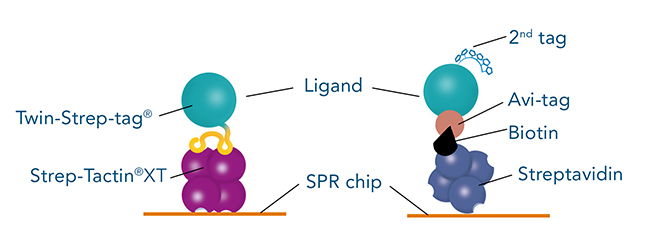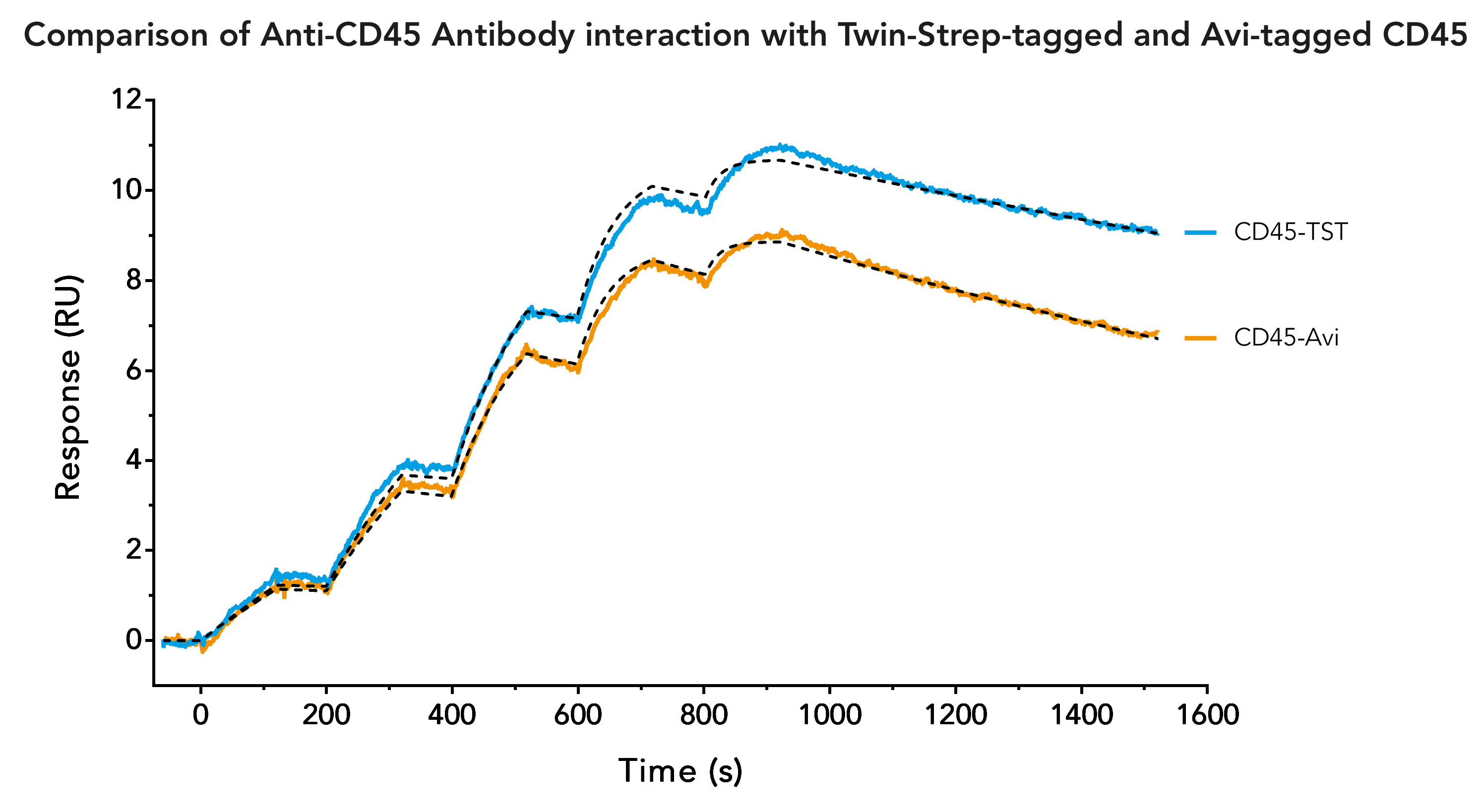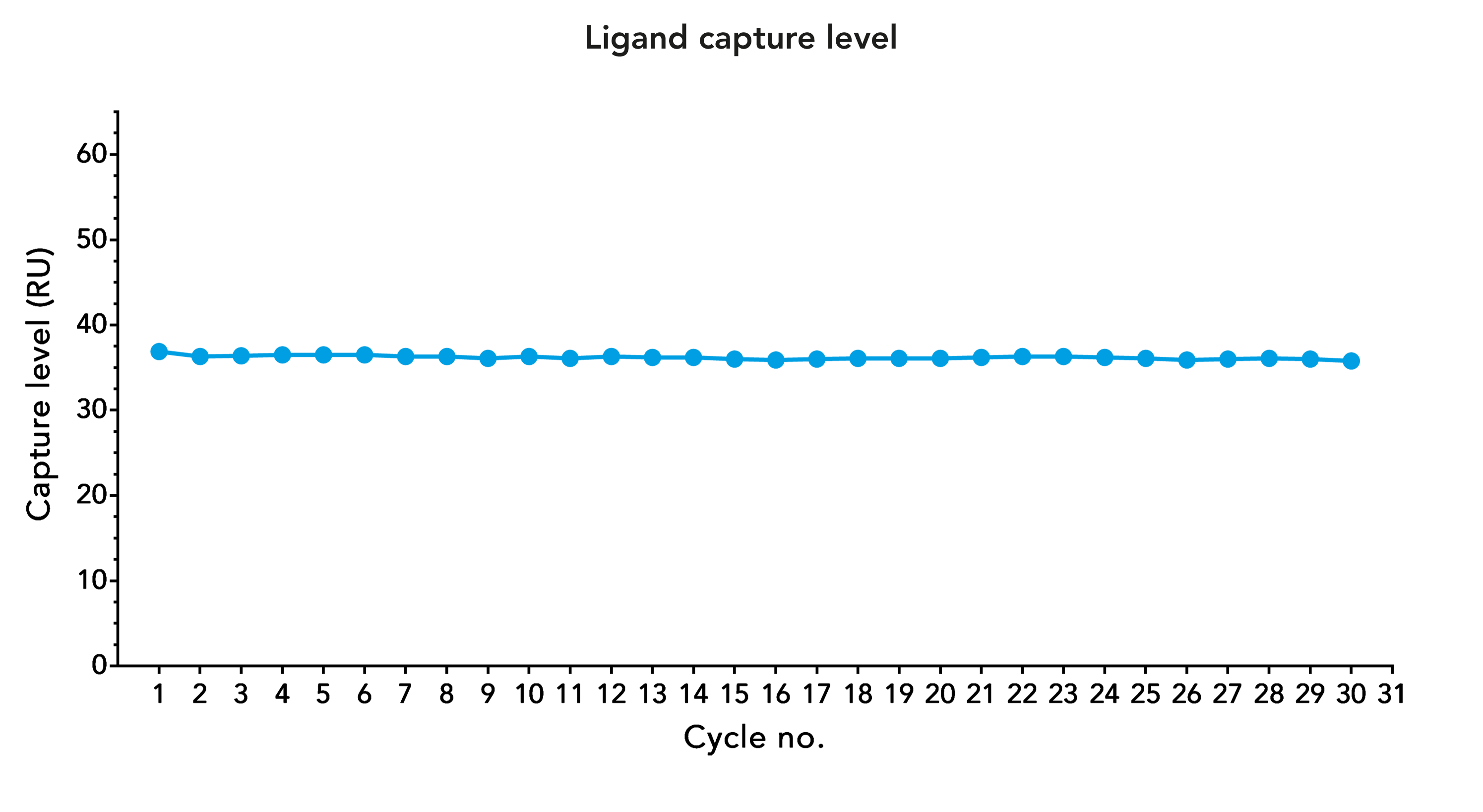Twin-Strep-tag® - a reliable and time saving alternative to Avi-tag in Surface Plasmon Resonance (SPR) analysis
Surface plasmon resonance (SPR) is a powerful method to study biomolecular interactions. Due to its high accuracy and ability to measure samples in high throughput, it plays a major role in research and development of drugs.
A common tag which is frequently used to immobilize ligands on SPR biosensor chips is the Avi-tag. It is characterized by its high binding affinity and specificity for streptavidin. The combination of Avi-tag and streptavidin allows long-term measurements of interactions with high affinity and slow dissociation rates.
Successful SPR measurements require a sufficient amount of highly pure ligand. Although its binding to streptavidin is very strong, the Avi-tag is not an ideal tag for initial purification of a chosen ligand. The available resins for purifying Avi-tag fusion proteins are expensive and only yield a low amount of protein. The solution for this is the use of a second, more suitable, tag for initial ligand purification. Due to its high purity in protein purification, as well as higher yield and lower costs, the Twin-Strep-tag® is often considered as second tag. Therefore, a frequently asked question is, if the Twin-Strep-tag® and the Avi-tag can be used on the same protein.
The answer is: Twin-Strep-tag® and Avi-tag should not be used on the same protein! The biotinylation of Avi-tag can interfere with the binding of Twin-Strep-tag®, since the binding partner of Twin-Strep-tag® is a streptavidin mutant called Strep-Tactin®XT. Strep-Tactin®XT still has an affinity to biotin and biotinylated proteins, which can affect SPR measurements. Conversely, Twin-Strep-tag® still has a weak affinity to streptavidin, which might influence SPR measurements as well.
The solution to the incompatibility of Avi-tag and Twin-Strep-tag® is quite simple. Avi-tag is not needed for SPR measurements, since Twin-Strep-tag® can be used just as effectively for protein immobilization. In addition to the suitability for the whole procedure from purification to immobilization, using Twin-Strep-tag® also has additional benefits:
- Strep-Tactin®XT has a pM affinity for Twin-Strep-tag® and therefore, the combination is ideally suited for analysis of interactions with high affinity and slow dissociation rates.
- The reversibility of the interaction allows reuse of the sensor chips
- Efficient and easy one-step purification method - no tedious additional biotinylation

Twin-Strep-tag® – direct and time-saving protein purification with high yields
Before a ligand can be used in SPR analysis, it must be expressed and purified. A high purity and a good yield are key for guaranteeing high quality SPR results.
When working with an Avi-tag fusion protein, the tag must be biotinylated in vivo or in vitro before it is operational. For each ligand, a biotinylation protocol must be developed. Afterwards, the success of the biotinylation must be verified, making the use of an Avi-tag overall a time-consuming procedure. In addition to the tedious process of implementing an optimal biotinylation protocol, the available purification resins for Avi-tagged proteins are expensive and only yield a low amount of target per ml resin.
Due to the low protein yield achieved with Avi-tag, the use of an additional tag only for purification may be necessary to obtain enough purified target protein. However, a second tag can disrupt the protein structure and activity. Therefore, an additional step to remove the purification tag prior to SPR analysis is often required.
The Twin-Strep-tag® is a protein tag that circumvents all the problems that are connected to using an Avi-tag. One important advantage is that it does not require any modifications after being fused to a protein of choice. It can be used directly to purify the ligand via a Strep-Tactin®XT resin in a simple one-step procedure. In addition, due to the mild purification conditions and variable buffer composition, the tag is suitable for any target protein. Based on a protocol that works equally well for every ligand, quick and easy purification with high yields is possible. Depending on the resin and protein, up to 33 mg protein per ml resin can be achieved with a purity greater than 95%.

Fig. 2: Protein analysis workflow with Twin-Strep-tag® and Avi-tag
The ease of use, the high purity and yield are all features that indicate that Twin-Strep-tag® is superior to Avi-tag for protein purification. On top of that, the high affinity to Strep-Tactin®XT offers the possibility for efficient ligand immobilization necessary for SPR or other analyses of binding kinetics, making the Avi-tag essentially redundant.
Twin-Strep-tag® provides pM affinity to study high affinity interactions
SPR analysis requires immobilization of a ligand on a biosensor chip. To achieve this, the Avi-tag/streptavidin interaction is commonly used, because the binding is characterized by an exceptionally high affinity. Another interaction that offers the possibility for efficient immobilization is the binding of Twin-Strep-tag® to Strep-Tactin®XT. With an affinity in a low picomolar range it can achieve similar results in SPR analyses as the Avi-tag/streptavidin combination. The half-life of Twin-Strep-tag®/Strep-Tactin®XT complex is 13 hours, enabling measurements of high affinity interactions over a long period of time.
The versatility of the Twin-Strep-tag®/Strep-Tactin®XT combination during purification and analyses makes it a great alternative to using the Avi-tag/streptavidin interaction. By choosing the Twin-Strep-tag®, the whole workflow will become a more time-saving and cost-effective process.
Comparable results with Twin-Strep-tag® and Avi-tag for analysis of high affinity interactions

Fig. 3: In a direct comparison, CD45 was fused to either a Twin-Strep-tag® (TST) or an Avi-tag (Avi) and immobilized using a CM5 sensor chip coated with Strep-Tactin®XT or a Sensor Chip CAP coated with streptavidin. 2.56, 6.4, 16, 40, and 100 nM anti-CD45 antibody were injected at 0, 200, 400, 600, and 800 s. Both systems delivered similar results.
Reduce costs with regenerative Strep-Tactin®XT biosensor chips
An interaction analysis always includes several measurements. Therefore, the option of reusing a biosensor chip would be highly beneficial since it reduces the costs associated with an experiment.
The possibility for biosensor chip regeneration exists for both the Avi-tag/streptavidin and the Twin-Strep-tag®/Strep-Tactin®XT system. However, important differences between these two systems are effectiveness, convenience of the procedure and costs for regenerating a chip.
Due to its high affinity, the Avi-tag/streptavidin interaction is too strong to dissolve and therefore the only efficient way to reuse a chip is to remove the whole ligand/streptavidin complex.
A new generation of streptavidin biosensor chips come with an established regeneration protocol. In this protocol, streptavidin is released during regeneration and must be re-applied before the next ligand application. A disadvantage of these streptavidin biosensor chips is that they are twice as expensive as Strep-Tactin®XT biosensor chips. A cheaper, but complex and often inefficient way is to use conventional streptavidin biosensor chips. For the regeneration of these chips, optimal regeneration conditions must be determined for each different ligand. After all, a new chip may be needed for each measurement anyway, since the procedure might also affect the ligand's activity.
In contrast to Avi-tag/streptavidin, which is a nearly irreversible binding, the Twin-Strep-tag®/Strep-Tactin® interaction can be dissolved easily. Although the binding affinity is very high, the addition of guanidine hydrochloride (GuHCl) causes the complete release of the strep-tagged ligand from Strep-Tactin®XT. Strep-Tactin®XT remains on the biosensor chip and is unaffected by this procedure. The protocol is fast and simple and allows regenerating the chips more than 30 times without adverse effects on functionality.
Stable performance of Strep-Tactin®XT biosensor chips after several regeneration cycle

Fig. 4: Ligand capture level of CD45-Twin-Strep-tag® on a Strep-Tactin®XT coated CM5 chip after several regeneration cycles. Regeneration was performed with three consecutive 1-minute injections of 3 M GuHCl.

